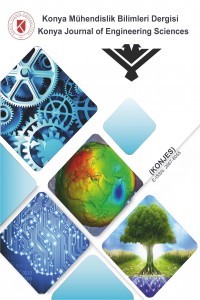ZAYIF KAYA MALZEMELERİNİN YERİNDE DAYANIMININ BELİRLENMESİNDE İNDEKS DENEYLERİN KULLANIMI İLE İLGİLİ BİR YAKLAŞIM
Kaya mekaniği, Yerinde indeks deneyler, Kiltaşı, Schmidt sertlik, Nokta yükleme dayanım
An approach to the use of index tests in determining of in-situ strength of weak rock materials
___
- Akbay, D., 2018, Nokta yükleme deneyinde yapılan hataların giderilmesi için yeni bir deney düzeneğinin tasarlanması, Süleyman Demirel Üniversitesi-FBE, Maden Mühendisliği ABD, Doktora Tezi, 218s.
- ASTM, 1993, Rock Testing Handbook, Test Standards, ASTM Publication, 947 p.
- Barton, N., 1973, Review of a new shear strength criterion for rock joints, Engineering Geology, Elsevier, Amsterdam, Cilt 7, ss. 287-332. Also NGI Publ. 105, 1974.
- Bieniawski, Z. T., 1975, Point load in geotechnical practice, Eng. Geol. 9: 1–11.
- Broch, E., Franklin, J. A., 1972, The point load strength test”, Int. J. Rock Mech. Mining Sci. 9: 669–697.
- Chau, K.T., Wong, R. H. C., 1996, Unixial compressive strength and point load strength, Int. J. Rock. Mech. Min. Sci, 33: 183–189.
- Deere, DU, Miller, RP, 1966. Engineering classifications and index properties of intact rock, Tech. Report No. AFWL-TR 65-116, Universty of Illinois
- Hawkins, A. B., 1998, Aspects of rock strength, Bulletin of Engineering Geology and the Environment, Bull Eng Geol Env., 57 : 17–30
- ISRM, 2007, The complete ISRM suggested methods for rock characterization, testing and monitoring: 1974-2006, International Soc. for Rock Mechanics, Commission on Testing Methods, Editor: R. Ulusay and John A. Hudson , ISBN: 978-975-93675-4-1, 628p.
- Kahraman, S., 2001, Evalution of simple methods for assesing the unixial compressive strength of rock, International Journal of Rock Mechanics, 981-994.
- Mesutoğlu M., Özkan İ., 2019, In-situ application of Schmidt hammer test on a coal face with large-scale, ISRM 14th International Congress on Rock Mechanics, 13-18 Eylül 2019, Foz do Igaçu-Brasil, Code:14287, 8p.
- Özkan, I., Bilim, N., 2008, A new approach for applying the in-situ Schmidt hammer test on a coal face, International Journal of Rock Mechanics and Mining Sciences, Cilt 45, No 6, ss. 888-898.
- Özkan, İ., 1989, Determination of classification parameters for weak and stratified rocks based on RMR and Q-systems, Yüksek Lisans Tezi, ODTÜ, 156s.
- Öztürk, C. A., Özbakır, A. D., Nasuf, E., 2004, Nokta yük ve tek eksenli basınç dayanımları arasındaki ilişkinin değerlendirilmesi, 6. Ulusal Kaya Mekaniği Sempozyumu.
- Peng, S. S. and Chiang, H. S., 1984. Longwall Mining. John Wiley & Sons, New York.
- Tsiambaos, G., Sabatakakis, N., 2004. Considerations on strength of intact sedimentary rocks. Engineering Geology 72, 261–273. https://doi.org/10.1016/j.enggeo.2003.10.001
- Ulusay, R., Özkan, İ. ve Ünal, E., 1995, Characterization of weak, stratified and clay bearing rock masses for engineering applications. Fractured and Jointed Rock Masses Conference, June 3-5, 1992, L.R. Mayer, N.W. Cook, R.E. Goodman and C.F. Tsang (eds.), Lake Tahoe, California, A.A. Balkema, ss. 233-240.
- Yenice, H., 2002. Bazı Kayaçlarin Tek Eksenli Basınç Dayanımları ile Diğer Malzeme Özellikleri Arasındaki İlişkiler. Dokuz Eylül Üniversitesi Mühendislik Fakültesi Fen ve Mühendislik Dergisi 4, 65–71.
- Yayın Aralığı: Yılda 4 Sayı
- Başlangıç: 2004
- Yayıncı: Konya Teknik Üniversitesi
KİRİŞLERDE BASINÇ DONATISI ORANININ MOMENT-EĞRİLİK İLİŞKİSİNE ETKİSİ
Süleyman YÜKSEL, Rohullah JAMAL, Saeid FOROUGHİ
Serap ERCAN CÖMERT, Harun Reşit YAZGAN, Büşra ÇAKIR, Nazan SARI
BATIK ULTRAFİLTRASYON MEMBRAN BİYOREAKTÖRÜ İLE GERÇEK GRİ SU ARITIMI
Can ASAN, Levent GÜREL, Hanife BÜYÜKGÜNGÖR
Telekom Yazılımı İş Yükü Karakterizasyonu
Hasan Erdinç KOÇER, Mahmut Sami YASAK
RADYOAKTIF PERTEKNETAT OKSO ANYONU ADSORPSIYONUNUN TERMODINAMIK ANALIZI
Fatih DEMIR, Omer LACIN, Burak BASTABAN
LQR KONTROLCÜ PARAMETRELERİNİN SİSTEM DAVRANIŞINA ETKİ ANALİZİ: ÇİFT ÇUBUKLU TERS SARKAÇ SİSTEMİ
GENİŞ BAŞLIKLI SAVAKLARDAKİ SAVAK YÜKLERİNİN DENEYSEL VE SAYISAL OLARAK MODELLENMESİ
Murat Can YILDIZ, Alpaslan YARAR
ÇAVUŞCUGÖL LİNYİT AÇIK OCAĞINDAKİ DURAYSIZLIKLARIN İNCELENMESİ
